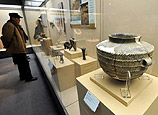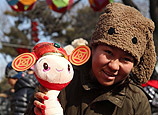
After the steaming comes the beating. Again, it is two-person work, with one person pounding the gaohua with a wooden or stone hammer, while the other adds cold water to the hot paste and turns it.
"Physics and chemistry tell us the process changes the molecular structure of rice, which makes the rice easier to digest. In my eyes, the morale is that without a beating one does not become mature," said Liu An'guo, the 18-year-old grandson of Liu Qishou.
The beaten rice paste is then put on a chopping block, hand-squeezed into small balls, and kneaded into a roll. To get the traditional look of Ningbo rice cake, a mould is pressed onto the roll and red stamp pressed on the shaped cake.
"It is hard to tell how many recipes have developed over the centuries. I bet there must be thousands of them. One thing, however, is certain, rice cake is friendly to other ingredients. It is never too dominant or too compliant - it maintains the fragrance and taste of rice, but is open to other flavors," said Wu Qinfeng, a rice cake stall owner in Cicheng.
"My favorite recipe is easy, if not lazy: Just put sun-dried rice cake slices into burning charcoal until it expands like popcorn. The aroma and the color are irresistible", said Wu.
 |  |
















 Young Spanish scientist has a career 'made in China'
Young Spanish scientist has a career 'made in China'


![]()
